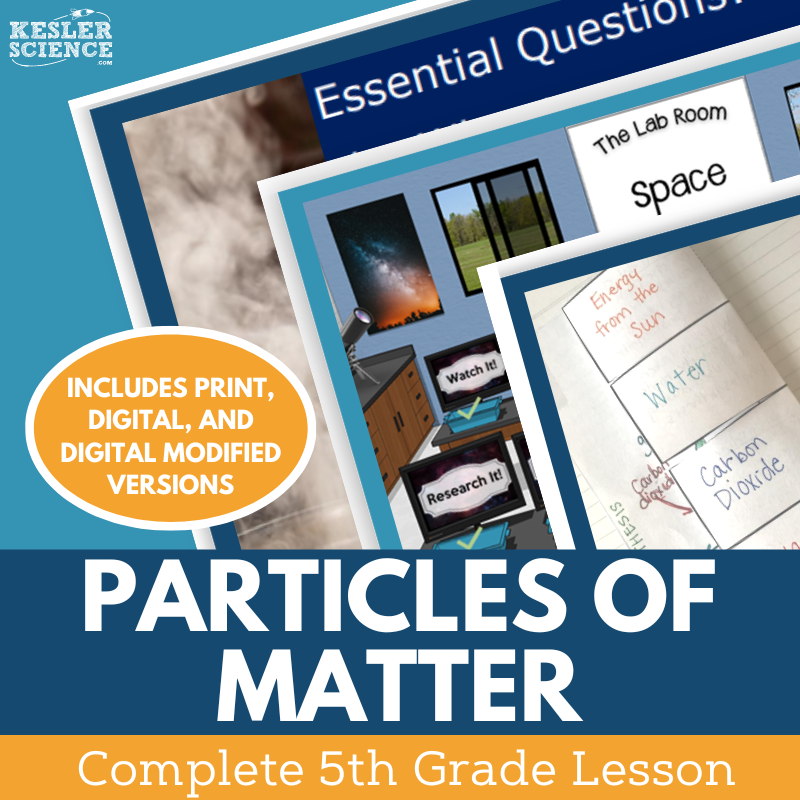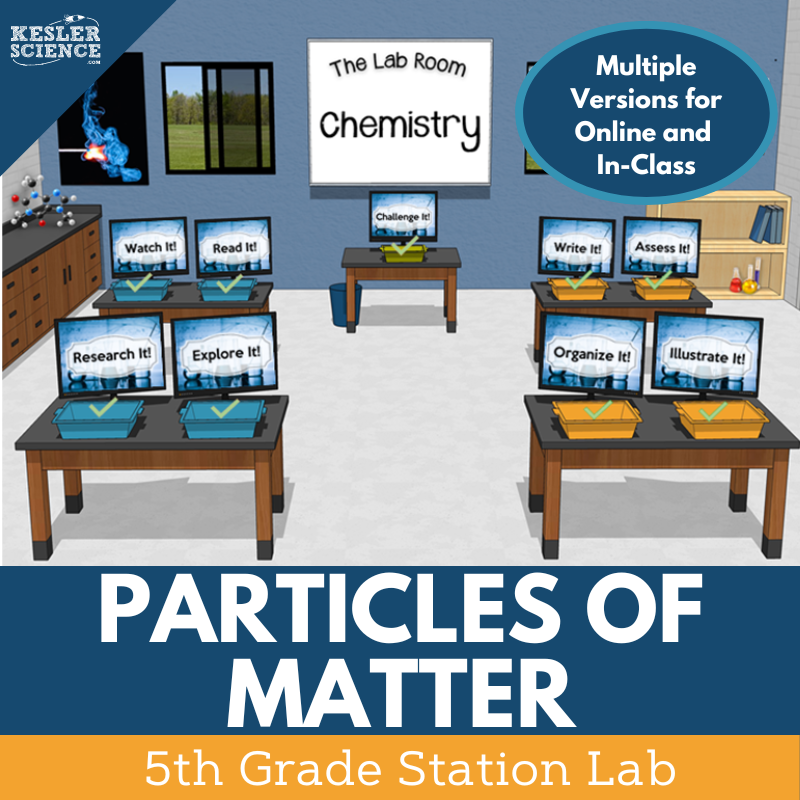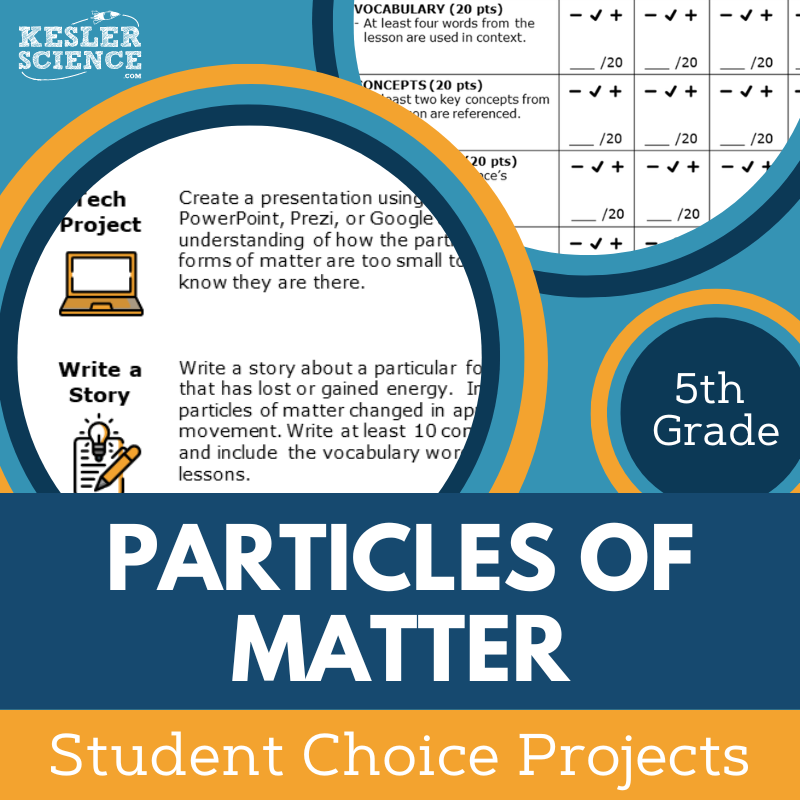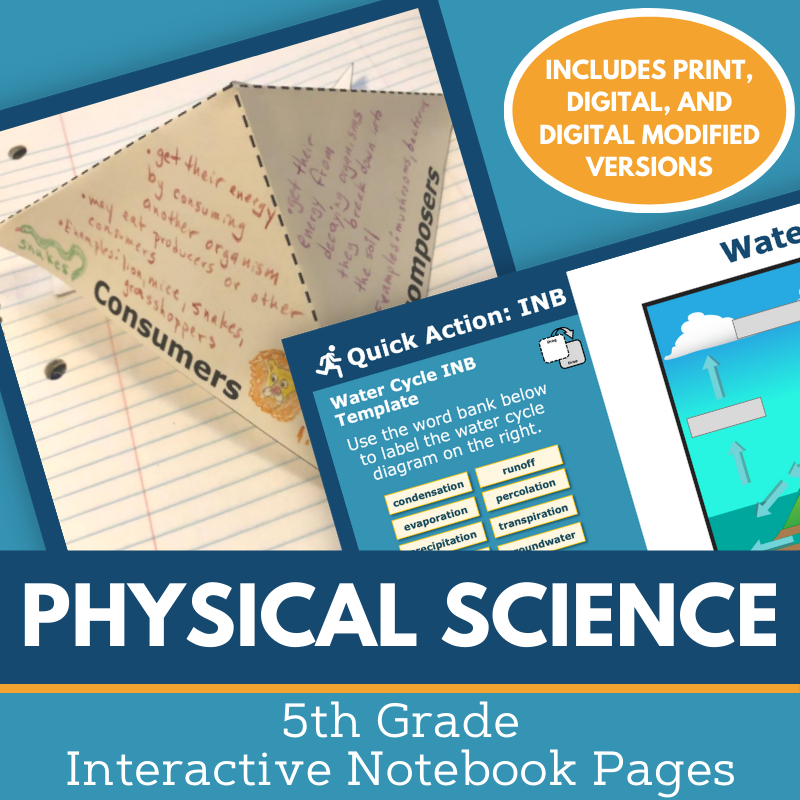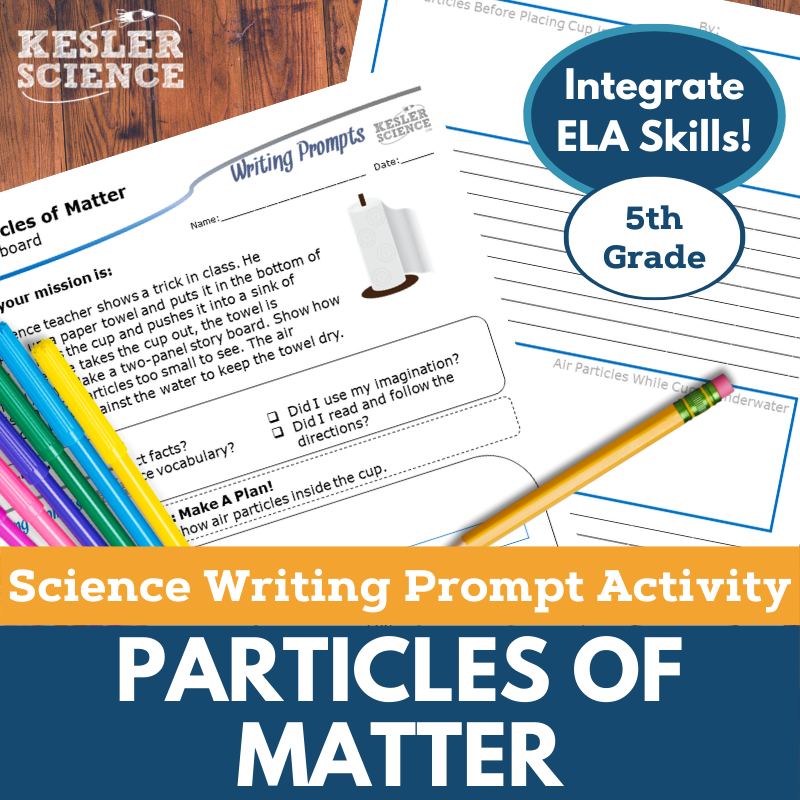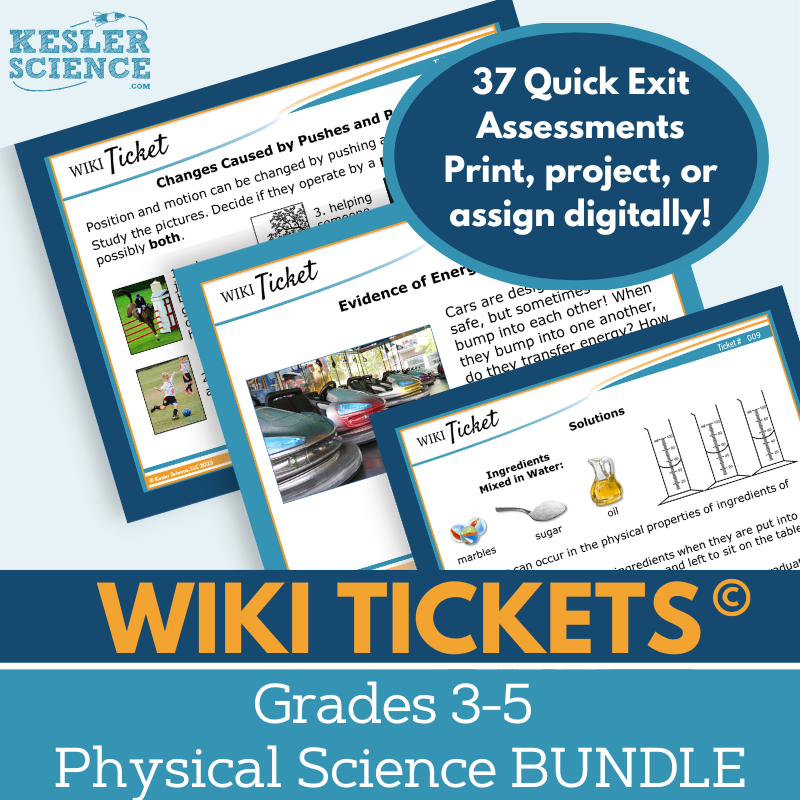Particles of Matter Activities for 5th Grade Science
The Kesler Science Particles of Matter 5th grade resources engage students in exploring the makeup of matter and the differences among solids, liquids, and gases through a student-led, inquiry-based approach. The resources below will give students a comprehensive understanding of particles of matter. All of the following materials are also included in the Kesler Science Membership.
Transform lesson planning into a breeze with the Kesler Science Particles of Matter 5th Grade Complete 5E Lesson. Packed with ready-to-go materials, this comprehensive lesson ensures your students are actively engaged and learning while saving you prep time. The lesson promotes student-led exploration, so you can focus on fostering real understanding.
Students will tackle essential questions such as, "What is matter made of?" and "How are the three states of matter different from each other?" The 5E Model (Engagement, Exploration, Explanation, Elaboration, and Evaluation) guides students through this topic with a range of differentiated activities to accommodate various learning styles.
From vocabulary cards and interactive notebooks to engaging station labs and editable PowerPoints, this lesson offers flexible formats for in-class or virtual learning. Spanish translations are included, along with multimodal resources like videos, hands-on experiments, reading passages, and digital activities, ensuring all students stay engaged and challenged.
Transform lesson planning into a breeze with the Kesler Science Particles of Matter 5th Grade Complete 5E Lesson. Packed with ready-to-go materials, this comprehensive lesson ensures your students are actively engaged and learning while saving you prep time. The lesson promotes student-led exploration, so you can focus on fostering real understanding.
Students will tackle essential questions such as, "What is matter made of?" and "How are the three states of matter different from each other?" The 5E Model (Engagement, Exploration, Explanation, Elaboration, and Evaluation) guides students through this topic with a range of differentiated activities to accommodate various learning styles.
From vocabulary cards and interactive notebooks to engaging station labs and editable PowerPoints, this lesson offers flexible formats for in-class or virtual learning. Spanish translations are included, along with multimodal resources like videos, hands-on experiments, reading passages, and digital activities, ensuring all students stay engaged and challenged.
The Kesler Science Particles of Matter Station Lab is an engaging, student-led activity that teaches 5th graders about the particles that make up matter. This modular station lab gives students the opportunity to lead their own learning, while teachers save valuable prep time. Students will create models to explain that matter is made of particles too small to be seen.
The lab includes eight differentiated activities, with a ninth challenge station for advanced students. Each of the nine stations is designed for independent or small group work and provides all the materials needed, including signage, resources, and task cards. Stations require minimal additional materials, most of which are likely already available in the classroom.
With multimodal activities such as hands-on experiments, reading, research, and videos, the lab engages students in diverse ways. Output stations encourage students to demonstrate their understanding through drawing, writing, and organizing, while the Challenge It! station offers extension activities for early finishers. The station lab is designed for both in-person and virtual learning environments.
The Kesler Science Particles of Matter Station Lab is an engaging, student-led activity that teaches 5th graders about the particles that make up matter. This modular station lab gives students the opportunity to lead their own learning, while teachers save valuable prep time. Students will create models to explain that matter is made of particles too small to be seen.
The lab includes eight differentiated activities, with a ninth challenge station for advanced students. Each of the nine stations is designed for independent or small group work and provides all the materials needed, including signage, resources, and task cards. Stations require minimal additional materials, most of which are likely already available in the classroom.
With multimodal activities such as hands-on experiments, reading, research, and videos, the lab engages students in diverse ways. Output stations encourage students to demonstrate their understanding through drawing, writing, and organizing, while the Challenge It! station offers extension activities for early finishers. The station lab is designed for both in-person and virtual learning environments.
The Kesler Science Particles of Matter Student Choice Projects offer 5th grade students the opportunity to select from six project options or create their own. With a grading rubric for teacher, peer, or self-assessment, these flexible projects cater to diverse student needs and allow for creative expression.
Designed to be adaptable, these projects offer nine choice board options and a “design your own” project. Teachers can modify the rubric to meet specific grading criteria, and the materials are easily accessible with basic classroom supplies like paper, markers, and scissors, with many projects available digitally.
Differentiated for a variety of learners, the project options include a modified version to support students needing remediation, while more advanced students can combine projects for a greater challenge. These student-led projects encourage personalized learning and foster independent thinking.
The Kesler Science Particles of Matter Student Choice Projects offer 5th grade students the opportunity to select from six project options or create their own. With a grading rubric for teacher, peer, or self-assessment, these flexible projects cater to diverse student needs and allow for creative expression.
Designed to be adaptable, these projects offer nine choice board options and a “design your own” project. Teachers can modify the rubric to meet specific grading criteria, and the materials are easily accessible with basic classroom supplies like paper, markers, and scissors, with many projects available digitally.
Differentiated for a variety of learners, the project options include a modified version to support students needing remediation, while more advanced students can combine projects for a greater challenge. These student-led projects encourage personalized learning and foster independent thinking.
The Kesler Science Physical Science Interactive Notebook bundle engages elementary students in 13 essential physical science topics with both print and digital formats. This versatile resource supports traditional classrooms, 1:1 environments, and distance learning, ensuring all students can actively participate.
The digital version includes an interactive PowerPoint that can be uploaded to Google Slides and various LMS platforms, with reflection pages, note-taking spaces, teacher answer keys, and a modified version for accommodations. The paper version provides blank and pre-filled templates, along with color photos for guidance.
Topics range from properties of matter and energy use to gravitational force and circuits. Whether used for interactive learning, differentiation, or student reflection, this notebook bundle makes science more engaging and accessible.
The Kesler Science Physical Science Interactive Notebook bundle engages elementary students in 13 essential physical science topics with both print and digital formats. This versatile resource supports traditional classrooms, 1:1 environments, and distance learning, ensuring all students can actively participate.
The digital version includes an interactive PowerPoint that can be uploaded to Google Slides and various LMS platforms, with reflection pages, note-taking spaces, teacher answer keys, and a modified version for accommodations. The paper version provides blank and pre-filled templates, along with color photos for guidance.
Topics range from properties of matter and energy use to gravitational force and circuits. Whether used for interactive learning, differentiation, or student reflection, this notebook bundle makes science more engaging and accessible.
The Kesler Science Particles of Matter Science and ELA Integrated Writing Activity allows 5th grade students to explore the concept of gas particles through an engaging storyboard format. This creative activity challenges students to apply their scientific knowledge while enhancing their writing skills. The flexible design supports both in-class and virtual learning environments.
Aligned with TEKS and NGSS, this activity is designed for ease of use with minimal prep. It provides a variety of formats, including full-sized and half-sheet handouts, a projection version, and a digital interactive PowerPoint. This allows for both physical and digital classroom settings, ensuring accessibility for all students.
Teachers are equipped with comprehensive directions, including an answer guide, project ideas, and rubrics for assessment. The activity is adaptable for differentiation, perfect for a range of learners and needs, and works well for cross-curricular activities, formative assessments, or as an enrichment task for early finishers.
The Kesler Science Particles of Matter Science and ELA Integrated Writing Activity allows 5th grade students to explore the concept of gas particles through an engaging storyboard format. This creative activity challenges students to apply their scientific knowledge while enhancing their writing skills. The flexible design supports both in-class and virtual learning environments.
Aligned with TEKS and NGSS, this activity is designed for ease of use with minimal prep. It provides a variety of formats, including full-sized and half-sheet handouts, a projection version, and a digital interactive PowerPoint. This allows for both physical and digital classroom settings, ensuring accessibility for all students.
Teachers are equipped with comprehensive directions, including an answer guide, project ideas, and rubrics for assessment. The activity is adaptable for differentiation, perfect for a range of learners and needs, and works well for cross-curricular activities, formative assessments, or as an enrichment task for early finishers.
The Kesler Science Physical Science WIKI Tickets provide 3rd–5th grade teachers with engaging, low-prep formative assessments. These colorful exit tickets help quickly gauge student understanding in chemistry, energy, and force and motion topics, aligning with NGSS and TEKS standards. Each of the 37 topics includes five formats: a full-screen display, three printable handout sizes, and a digital interactive version in PowerPoint or Google Slides.
WIKI Tickets are versatile for any learning environment. Teachers can project them for class discussions, print them for written responses, or assign them digitally for remote learning. The included table of contents file ensures seamless alignment with science standards, making assessments easy and effective.
With WIKI standing for “What I Know Is,” these tickets work as bellringers, exit slips, or quick checks for understanding. Whether in class or online, this resource offers a simple yet powerful way to track student progress in physical science concepts.
The Kesler Science Physical Science WIKI Tickets provide 3rd–5th grade teachers with engaging, low-prep formative assessments. These colorful exit tickets help quickly gauge student understanding in chemistry, energy, and force and motion topics, aligning with NGSS and TEKS standards. Each of the 37 topics includes five formats: a full-screen display, three printable handout sizes, and a digital interactive version in PowerPoint or Google Slides.
WIKI Tickets are versatile for any learning environment. Teachers can project them for class discussions, print them for written responses, or assign them digitally for remote learning. The included table of contents file ensures seamless alignment with science standards, making assessments easy and effective.
With WIKI standing for “What I Know Is,” these tickets work as bellringers, exit slips, or quick checks for understanding. Whether in class or online, this resource offers a simple yet powerful way to track student progress in physical science concepts.
Year-Round Resources
These year-round activities will increase your students' understanding of many middle school science topics. All of these activities are also included in the Kesler Science Membership.
Visual Data & Graphing
You're not alone if your students struggle with understanding graphs, charts, and tables. It's a skill that takes an enormous amount of practice. This resource will help students build a strong foundation in analyzing data and creating their own data visualizations.
Bell Ringers and Warm-Ups
These middle school science bell ringers are an excellent way to engage your students as soon as they walk into your classroom. This comprehensive FULL YEAR resource includes everything you need to start off each science class with an interesting warm-up activity.
Review Board Games
Each game board has been carefully designed to keep students engaged. There are 10 different action spaces on each board and dozens of question cards. All of the actions are related to science concepts and keep the students motivated throughout the game.
Each game is ready to play. Simply print out the board and the cards and let the students enjoy reviewing nine different units.
Essential Questions
Below are the essential questions associated with the lessons and activities included in this unit. This topic is only one of more than 100 middle school science topics included in the Kesler Science Membership.
-
What is matter made of?
-
How are the three states of matter different from each other?
Kesler Science Membership
Imagine never having to search for another middle school science lesson again. The membership gives you access to ALL of the Kesler Science products in one place (Yes, including everything above).
Say goodbye to long hours of lesson prep.

